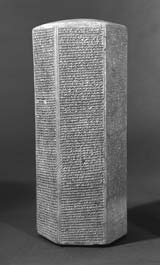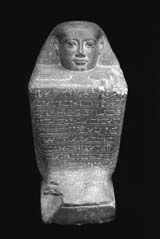| |
|
 |
 |
 |
 |
The Sculpted Word- Inscriptions
from the British Museum, 2001.
Gallery 4, Henry Moore Institute, Leeds, curated by James
Putnam and Stephen Feeke. 11 June - 16 September 2001.
'The Sculpted Word' examined the art of inscribing as a sculptural process which involves carving, making or engraving
words or pictograms, in varying degrees of relief and often in durable materials. From the earliest time in human history
pictorial signs have been inscribed in stone and clay. The act of cutting into materials, especially hard stone was an
expression of the evocative power of the word or symbol. Central to this artistic practice is the representation of space as
an integral part of the surface with details often carefully subordinated to more important features of the overall composition.
This interrelation of spatial design shows an understanding of the undercuts and accents which create light and shade.
The exhibition consisted of 17 inscribed objects selected from the British Museum which explored this basic premise.The variety
of the texts inscribed on different materials range from the sacred to the everyday, and the cultures they come from become
interwoven to express common human ideals and aspirations.When these objects are normally displayed, it is within a conventional
museological setting based on chronological and cultural criteria. By exhibiting them in the Henry Moore institute, however,
the viewer was given quite different perspectives on them. The more intimate space meant that attention could be focused on
this small number of choice objects. Moreover, reframed in an 'art' context it was possible to explore them in terms of their
visual and thematic potential.
Selected images:
1st image from top:
The Taylor Prism (Annals of Shennacherib), baked clay, from Nineveh, 691BC
Such prisms were often buried in the hope that subsequent generations would discover them and learn about a ruler's achievements
and successes. This fine example played a significant part in the deciphering of cuneiform.
2nd image from top:
Block sculpture of Harwa, green basalt, from Egypt, c747-656 BC
This type of sculpture would have been placed in temples or mortuary chapels and inscribed with prayers in hieroglyphs.
3rd image from top:
Relief with votive inscription to Asklepios, marble, from Greece, 100-200 AD
Such representations of afflicted body parts were placed at healing shrines as thanks for a cure or in the hope of finding one.
The inscription is dedicated to the gods Asklepios and Hygieia, associated with healing, renewal and medicine.
|
|
 |
 |
Taylor Prism.
|
 |
 |
Block Statue of Harwa.
|
 |
 |
Relief of Asklepios.
|

|
 |
 |
|
|
|